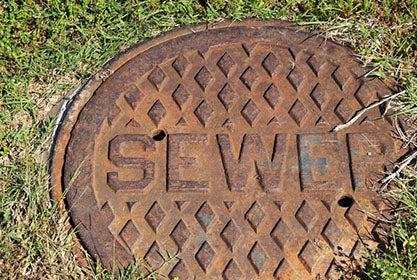
Case Study: Beef Processing Plant
Problem
A large beef processing plant was experiencing severe grease build up due to high levels of animal fat flowing through the beef processors two grease traps. Each trap consisted of five tanks in a series, with a total capacity of 30,000 gallons. One series was pumped three times per week and the other series was pumped five times per week. They were also on a daily manual dosage of specialized grease eating dry bacteria, which was thrown directly into the traps through the manholes, and an automated continuous treatment program using specialized grease eating liquid bacteria that were being fed from inside the plant.

The client was unhappy with the current program due to it’s high direct and indirect costs. The plant’s grease traps would regularly back up and overflow and there were still odor complaints.
Treatment Objectives
The objectives were: to replace annual bacterial costs of $48,000.00, to replace annual pumping costs of $63,000.00, to reduce the indirect cost of 2 man-hours per day, and finally to reduce or eliminate odor complaints.
An initial analysis of the grease traps by Great Lakes Bio Systems, Inc. personnel revealed that they were using a gram-positive bacteria (spore form). It was further determined that the entire grease trap system had about four hours of retention time. The four hour retention time was determined to be an insufficient amount of time to effectively propagate the gram-positive bacteria. Gram positive bacteria typically require four hours to prepare themselves for activation, and another one-half hour to begin to multiply. So in essence the bacteria were literally being “thrown down the drain.”
Equipment and Chemistry
The grease trap project utilized four (4) MixAir Technologies, Inc. Spider™ SA-12 units in each of the first four basins of the grease traps. These four SA-12 units were used for their aerating ability as well as their tremendous mixing capability.
Each diffuser was powered by a BSRV-75 blower which pushes 9 SCFM of air. This blower/diffuser combination mixes 225,000 gallons per hour per grease trap cell.

In addition to the diffuser/blower combination, each of the four separate drain lines from each of the production areas were fed continuously by peristaltic pumps. Two of the pumps units would feed 0.7 gallons per day of Orb-3 Wastewater Treatment Enzyme product and the other two units would feed 0.3 gallons per day. The pumps were capable of feeding up to 5 gallons of concentrated product per day. Each pump dilutes the concentrated GLB product into 360 gallons of fresh tap water. This serves a special purpose. The dilution allows for better dispersion of the product by eliminating “hot spots” in the waste stream. Each pump was also placed as far into the production area as possible resulting in an additional two hours of treatment time plus the normal 4 hours of retention time in the grease traps. As the enzymes entered the waste stream, they began to work immediately, not four hours later like the gram-positive bacteria.
Results
Positive results were evident in the first 30 days. The odor complaints were substantially reduced and the consistency and color of the effluent in the grease traps began to change for the better. The effluent went from a black anaerobic color to a brown somewhat aerobic color. The effluent took on a more consistent texture, instead of being large chunks of grease and black water. Pumping was done on a 50% reduced schedule during this period to ensure there were no serious problems.
Over the next 90 days the results were good enough that the client decided to do a complete manual clean out of the system and sign an annual contract for the Orb-3 Wastewater Treatment Enzyme product. They also budgeted in quarterly pumpings as a precaution until the new system was fully established.
Capital Costs: One time equipment expense was less than $20,000.00.
Operational Costs: Annual quarterly pumping and product costs were less than $75,000.00.
The average annual savings with enzymes versus the previous system (not including the indirect savings of 500 man-hours per year) was $36,000.00 annually. They are on their fourth annual contract and last year they did not have to pump at all.